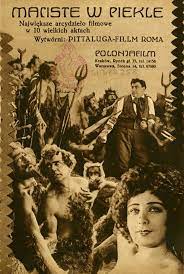
Maciste (Bartolomeo Pagano) is a virtuous man. He has come to the attention of the underworld. The king of hell is Pluto (Umberto Guarracino). Pluto tells his minister of hell, Gerione (Mario Saio), to send for his lieutenant, Barbariccia (Franz Sala). Barbariccia is ambitious and covets Pluto’s position. At first he refuses but when he is reminded that he has been having an affair with Pluto’s second wife, Proserpina (Elena Sngro), he decides to go. Pluto sends Barbariccia and some minions to Earth to get souls for hell and to especially defeat Maciste. Barbariccia and his minions cross the river Styx. Once they are on the other side they assume human form.
Barbariccia tries to seduce Maciste to the dark side by offering him gold and pleasures of the flesh but Maciste is not swayed. When that doesn’t work Barbariccia decides to use Maciste’s neighbor Graziella (Pauline Polaire) as a pawn in a wicked game. Maciste is protective of Graziella and is secretly in love with her. Barbariccia arranges for the young and handsome Giorgio (Domenico Serra) to have an accident in front of Graziella’s house. The kind and gentle woman takes Giorgio in and nurses him back to health. They fall in love and have an affair. When Graziella tells Giorgio that she is pregnant Giorgio disappears.
Graziella is heartbroken but devotes herself to her baby. Maciste does what he can for them. Barbariccia tells Graziella that Giorgio has returned but is with another woman. Graziella is devastated. Maciste goes to confront Giorgio and insists he fulfill his obligations. In the meantime Barbariccia steals Graziella’s baby. Maciste finds the baby and returns it. Maciste then goes after Barbariccia who grabs him and brings him down to hell. This is where Maciste’s trials really begin.
“Maciste in Hell” AKA “Maciste all'inferno” was released in 1926 and was directed by Guido Brignone. It is a silent fantasy film. This is not the same sword and sandal Maciste that is in all the peplum movies. In this film Maciste is a super strong man but he is not Roman but a modern day man. At least modern for the 1920’s. The film had some issues with the censors. Considered blasphemous for its depictions of hell and Lucifer the main devil character’s name ended up changed to King Pluto. The film is said to have inspired Federico Fellini to become a filmmaker.
When demons are walking around on Earth they were capes and top hats with curled moustaches. They basically all look like Snidely Whiplash. When they’re in hell all the men have long pointed beards, horns and carry pitchforks and all the women look like Greek sirens. Like most films of the silent era the depiction of hell is colorful and fanciful. The tinting is wonderful and the vision of hell is a combination of Dante Alighieri, Hieronymus Bosch and Gustave Dore. The imagery is frightening and quite biblical. The first half of the film was good but it really got fascinating once everyone went to hell.
The film has been wonderfully restored; however, it has Italian intertitles. The English intertitled film is not as pristine and the top is cropped off so sometimes people are missing their heads. It’s still a nice film and exciting to watch.
The Maciste character has been in film from 1914 to the mid 60’s. At least 52 films were done. 27 films on the character were done in the silent era alone. Bartolomeo Pagano played the character in all of them. The first Maciste film was “Cabiria” 1914. 25 films were done in the 60’s with various buff musclemen playing the lead. Then in the 70’s Jesus Franco did two films using the Maciste character. In Franco’s films he was an adventurer.

